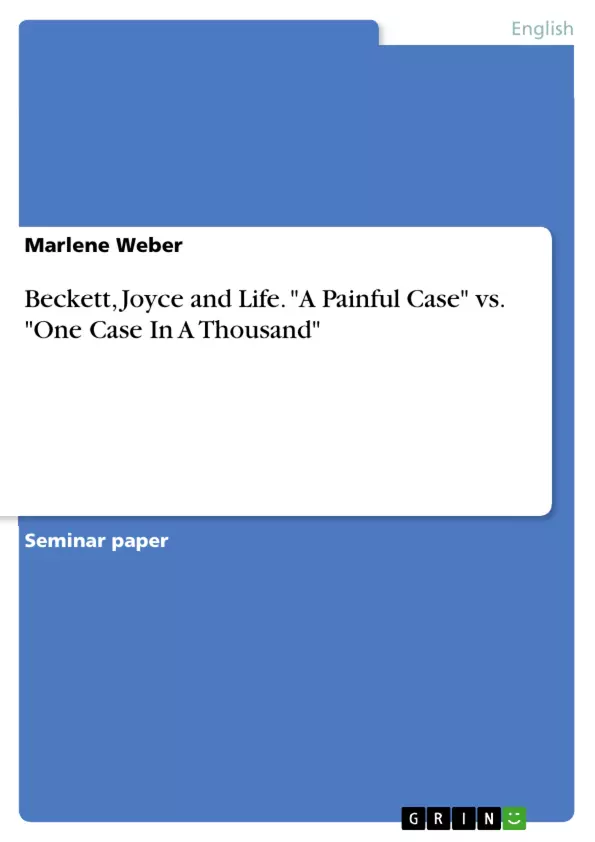“I write about myself with the same pencil and in the same exercise book as about him. It is no longer I, but another whose life is just beginning.” (Samuel Beckett)
These words by Samuel Beckett (1906 –1989), a remarkable literary talent of the past century, illustrate quite well the connection between Beckett and his stories. Quite often the writer used parts from his own life as models for his novels, poems and short stories. In the scope of this paper this will be exemplified on a relatively unknown short story written by him in 1934, "One Case in a Thousand". At the same time, I would like to show another influence on Beckett's work besides his biography. Therefore, the relationship between the two Irish writers Samuel Beckett and James Joyce will also be a central part of this work. This influence will be examined by a comparison of the above mentioned short story written by Beckett and another one written by Joyce, namely "A Painful Case" (1914).
Beckett's experiences gave him many sources of inspiration for his work, as his literary career was not always secure and success at times out of grasp. There were many disturbances, private as well as job-related ones, and his path was not always straight-lined. Writing seemed to be a cure when life was hardly bearable. It was not until the late 1930s, after the publication of Murphy in 1938 and also after the Second World War in particular, that he became quite well-known. He found a larger circle of readers which enabled him to concentrate on his creative literary work at last, which was finally acknowledged by the award of the Nobel Prize in 1969. Today, his plays "Endgame" (1957) and "Waiting for Godot" (1952) are well-known across the globe. However, the work which formed the major part of his writing, such as his poems, plays and short stories, is still not entirely common ground. This is one of the reasons why I wanted to focus on his short story "One Case in a Thousand", and also, because it contains a lot of autobiographical hints.
Inhaltsverzeichnis (Table of Contents)
- Introduction
- Main Part
- Beckett's life between 1920 and 1940
- Psycho-Analytical Aspects
- Beckett and Joyce
- "A Painful Case" (1914)
- "One Case in a Thousand” (1934)
- Summary and Conclusion
- Bibliography
Zielsetzung und Themenschwerpunkte (Objectives and Key Themes)
This paper aims to explore the connection between Samuel Beckett's life and his writing, particularly through the lens of his short story "One Case in a Thousand." The analysis will delve into biographical aspects of Beckett's life, focusing on the period between 1920 and 1940, and examine the influence of James Joyce on his work. By comparing "One Case in a Thousand" with Joyce's "A Painful Case," the paper seeks to understand how Joyce's writing style impacted Beckett's own.
- The influence of biography on Samuel Beckett's writing
- The relationship between Samuel Beckett and James Joyce
- The impact of Joyce's writing style on Beckett's work
- A comparative analysis of "One Case in a Thousand" and "A Painful Case"
- The autobiographical elements in Beckett's short story "One Case in a Thousand"
Zusammenfassung der Kapitel (Chapter Summaries)
- Introduction: This chapter introduces the reader to the main themes and objectives of the paper. It highlights Beckett's tendency to draw inspiration from his own life and explores his relationship with James Joyce.
- Beckett's life between 1920 and 1940: This chapter delves into Beckett's biographical details during a significant period in his life. It covers his time at Trinity College, Dublin, his relationship with his family, his early teaching positions, and his introduction to James Joyce in Paris.
- Psycho-Analytical Aspects: This chapter examines Beckett's involvement with psychoanalysis during the 1930s. It highlights his sessions with Dr. Bion and discusses the impact of psychoanalysis on his writing.
- Beckett and Joyce: This chapter explores the connection between Beckett and Joyce, focusing on Joyce's mentorship and influence on Beckett's writing style.
- "A Painful Case" (1914): This chapter analyzes Joyce's short story "A Painful Case," providing insight into its themes and stylistic elements.
- "One Case in a Thousand" (1934): This chapter examines Beckett's short story "One Case in a Thousand" and explores its autobiographical elements. It analyzes the story in relation to Joyce's "A Painful Case" and discusses the impact of Joyce's writing style on Beckett's work.
Schlüsselwörter (Keywords)
This paper focuses on key terms such as Samuel Beckett, James Joyce, "One Case in a Thousand," "A Painful Case," biographical influence, writing style, psychoanalysis, literary influence, and Irish literature. It explores the connection between personal experiences and literary expression, highlighting the impact of Joyce on Beckett's creative work.
- Quote paper
- Marlene Weber (Author), 2015, Beckett, Joyce and Life. "A Painful Case" vs. "One Case In A Thousand", Munich, GRIN Verlag, https://www.grin.com/document/296217



